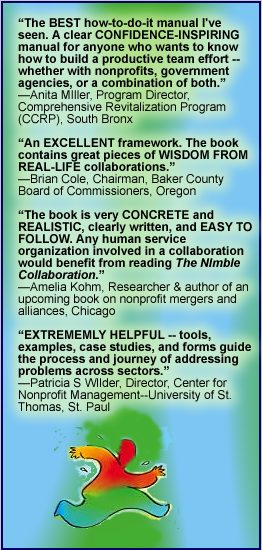The Nimble Collaboration
Fine Tuning Your Collaboration for Lasting Success
Reviewed by Beth Waterhouse
Author Karen Ray reflects, “Collaboration between organizations, schools, businesses, or even sectors in society is never more important than in a tight economy.” When times are tough, there is no more important time to come together, no more important time to protect the cost-saving collaborations already proven effective. “It’s a time,” says Karen Ray, “when we can’t afford faulty starts and expensive mistakes.”
Ray’s Nimble Collaboration (2002) adds to the written expertise on the subject takes the discussion of collaboration to the next stage: trouble-shooting, fine-tuning, and making partnerships more effective. Its audience is the nonprofit manager or board member inside the American nonprofit sector.
“Capable collaboration” is not an oxymoron. Collaboration in the organizational sense means, “A relationship entered into by two or more organizations to achieve a result no one organization can achieve alone, and committing to lasting success.” Today, working in collaboration is a must for many organizations. Museums and galleries work with government to promote art. Public health departments provide services for children in elementary schools. Social service agencies establish offices in libraries. Furthermore, foundations have invested in collaboration, thinking it one way to push systems to change faster and wiser.
This guidebook aims to make collaborating “nimble” by focusing on results, shaping relationships, and structuring for resilience. In chapters interspersed with anecdotes and sidebar “fables” the reader learns about straightforward elements such as remembering your promises, stating your mission and vision, and clarifying desired results as outcomes. Chapter two focused on relationships and the underlying issue of trust. “To build trust, share hope,” states author Karen Ray.
The magic of this guidebook may well be Chapter Three, a stand-alone section on resiliency. The Ten Principles of Resilience are set forth as ten things that make collaboration nimble. Principles focus on leadership, equity, systems change, shared power, managed conflict, and less bureaucratic collaboration. The nimble collaboration actively employs these principles of resilience, as could a nimble state agency or a nimble large nonprofit in transition or a nimble rural community.
Part one of the book works in the abstract (salted with fables) and part two applies nimble strategies to real-life, in two main areas: collaborating to integrate services and collaborating to resolve complex issues. One good example of the former is Atlanta’s “211” phone number which has become a national model in giving free access to human services and health information. Collaboration to resolve complex issues might be exemplified by partners in a rural county coming together to develop a regional plan for economic development.
The 120-page book includes sample forms and agreements, and an excellent resource list on the topic of collaboration. “This book testifies to the power of working together. Work in partnership is witness to the potent changes for kids, parents, couples, singles, and seniors—for the community and the various systems that shape it—when people agree to undergo the precipitous work of collaboration.” After reading this sharply written, experiential account, the reader will be far smarter (nimble, indeed) when setting forth toward organizational partnerships.


